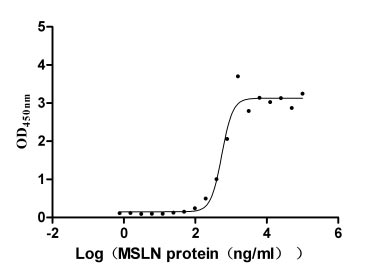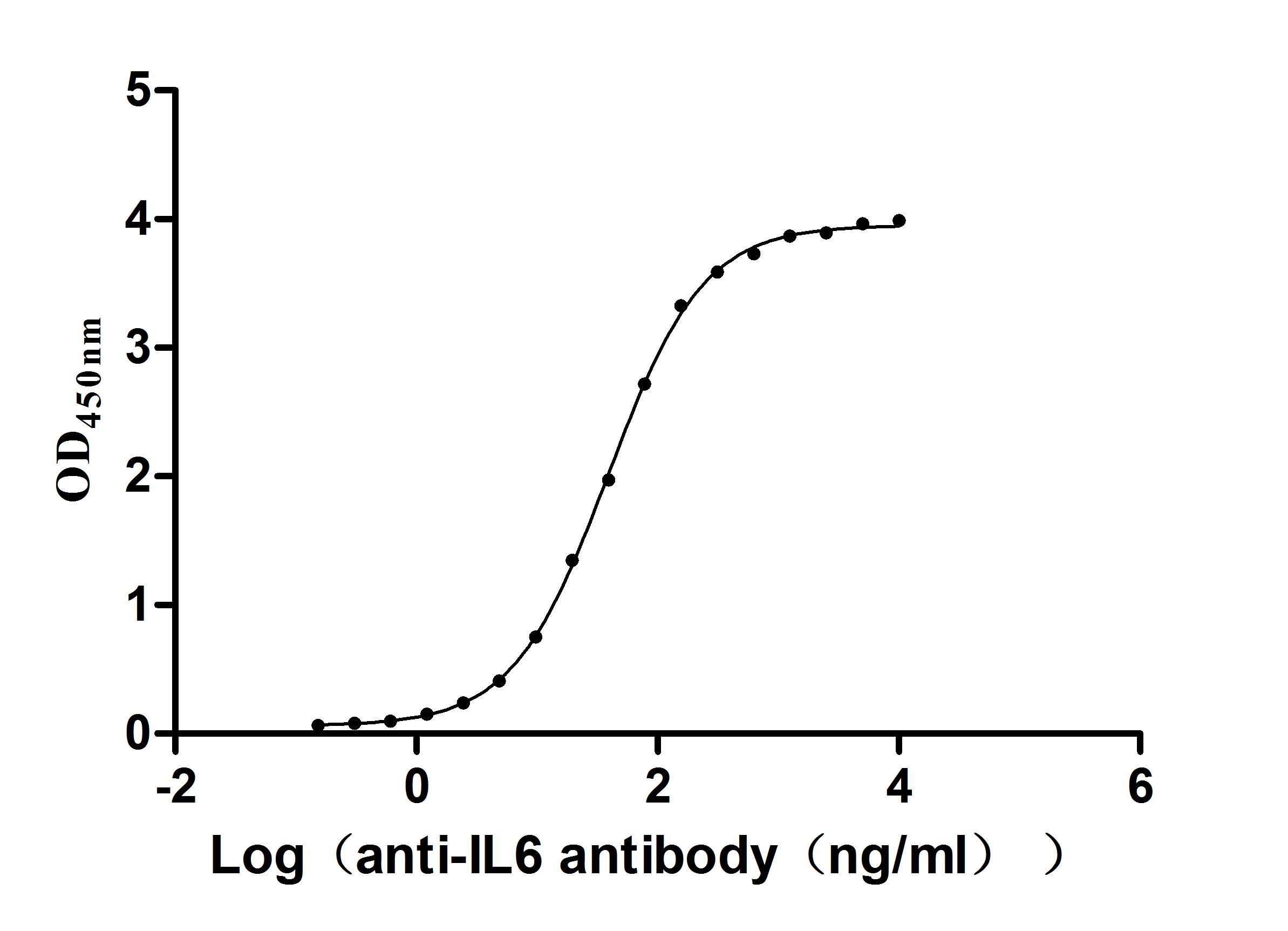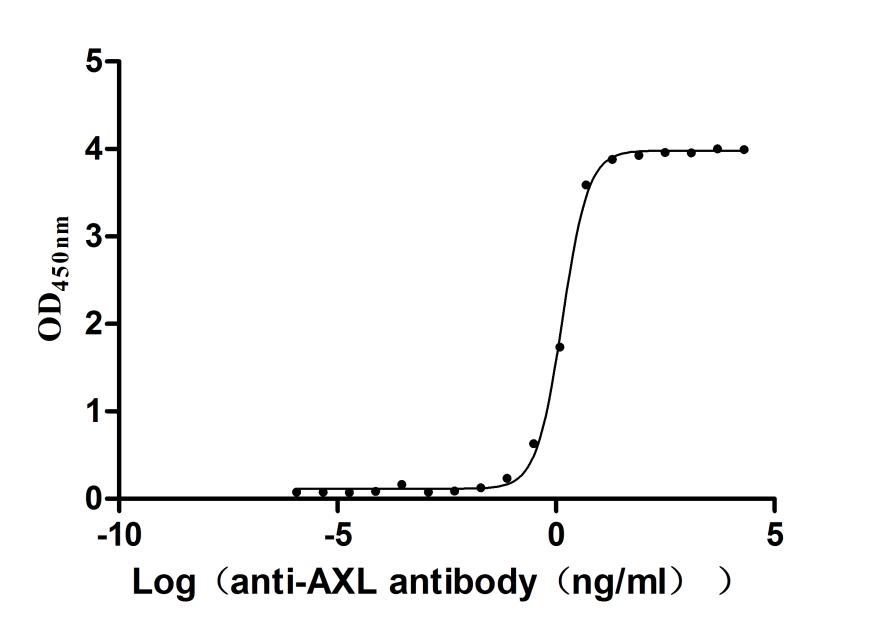Recombinant Mouse Chemokine-binding protein 2 (Ccbp2)
-
货号:CSB-CF004618MO
-
规格:
-
来源:in vitro E.coli expression system
-
其他:
产品详情
-
基因名:
-
Uniprot No.:
-
别名:Ackr2; Ccbp2; D6; Atypical chemokine receptor 2; C-C chemokine receptor D6; Chemokine-binding protein 2; Chemokine-binding protein D6
-
种属:Mus musculus (Mouse)
-
蛋白长度:Full length protein
-
表达区域:1-378
-
氨基酸序列MPTVASPLPLTTVGSENSSSIYDYDYLDDMTILVCRKDEVLSFGRVFLPVVYSLIFVLGL AGNLLLLVVLLHSAPRRRTMELYLLNLAVSNLLFVVTMPFWAISVAWHWVFGSFLCKVIS TLYSINFYCGIFFITCMSLDKYLEIVHAQPLHRPKAQFRNLLLIVMVWITSLAISVPEMV FVQIHQTLDGVWHCYADFGGHATIWKLYLRFQLNLLGFLLPLLAMIFFYSRIGCVLVRLR PPGQGRALRMAAALVIVFFMLWFPYNLTLFLHSLLDLHVFGNCEISHRLDYTLQVTESLA FSHCCFTPVLYAFCSHRFRRYLKAFLSVMLRWHQAPGTPSSNHSESSRVTAQEDVVSMND LGERQSEDSLNKGEMGNT
Note: The complete sequence including tag sequence, target protein sequence and linker sequence could be provided upon request. -
蛋白标签:N-terminal 10xHis-tagged
-
产品提供形式:Liquid or Lyophilized powder
Note: We will preferentially ship the format that we have in stock, however, if you have any special requirement for the format, please remark your requirement when placing the order, we will prepare according to your demand. -
缓冲液:Lyophilized from Tris/PBS-based buffer, 6% Trehalose, pH 8.0
-
储存条件:Store at -20°C/-80°C upon receipt, aliquoting is necessary for mutiple use. Avoid repeated freeze-thaw cycles.
-
保质期:The shelf life is related to many factors, storage state, buffer ingredients, storage temperature and the stability of the protein itself.
Generally, the shelf life of liquid form is 6 months at -20°C/-80°C. The shelf life of lyophilized form is 12 months at -20°C/-80°C. -
货期:Basically, we can dispatch the products out in 1-3 working days after receiving your orders. Delivery time may differ from different purchasing way or location, please kindly consult your local distributors for specific delivery time.Note: All of our proteins are default shipped with normal blue ice packs, if you request to ship with dry ice, please communicate with us in advance and extra fees will be charged.
-
注意事项:Repeated freezing and thawing is not recommended. Store working aliquots at 4°C for up to one week.
-
Datasheet & COA:Please contact us to get it.
相关产品
靶点详情
-
功能:Atypical chemokine receptor that controls chemokine levels and localization via high-affinity chemokine binding that is uncoupled from classic ligand-driven signal transduction cascades, resulting instead in chemokine sequestration, degradation, or transcytosis. Also known as interceptor (internalizing receptor) or chemokine-scavenging receptor or chemokine decoy receptor. Acts as a receptor for chemokines including CCL2, CCL3, CCL3L1, CCL4, CCL5, CCL7, CCL8, CCL11, CCL13, CCL17, CCL22, CCL23, CCL24, SCYA2/MCP-1, SCY3/MIP-1-alpha, SCYA5/RANTES and SCYA7/MCP-3. Upon active ligand stimulation, activates a beta-arrestin 1 (ARRB1)-dependent, G protein-independent signaling pathway that results in the phosphorylation of the actin-binding protein cofilin (CFL1) through a RAC1-PAK1-LIMK1 signaling pathway. Activation of this pathway results in up-regulation of ACKR2 from endosomal compartment to cell membrane, increasing its efficiency in chemokine uptake and degradation. By scavenging chemokines in tissues, on the surfaces of lymphatic vessels, and in placenta, plays an essential role in the resolution (termination) of the inflammatory response and in the regulation of adaptive immune responses. Plays a major role in the immune silencing of macrophages during the resolution of inflammation. Acts as a regulator of inflammatory leukocyte interactions with lymphatic endothelial cells (LECs) and is required for immature/mature dendritic cells discrimination by LECs.
-
基因功能参考文献:
- ACKR2 (Ccbp2) is a key regulator of myeloid differentiation and function and its targeting unleashes the anti-metastatic activity of neutrophils. PMID: 29445158
- ACKR2 is induced after traumatic brain injuries and has a significant impact on mortality and lesion development acutely following closed head injury. PMID: 29176798
- ACKR2 is an important regulator of branching morphogenesis in diverse biological context; this provide the first evidence of a role for chemokines and their receptors in postnatal development processes. PMID: 27888192
- Ackr2 expression levels limits development of cutaneous inflammatory responses in psoriasis. PMID: 27568525
- ACKR2 deletion reduced renal inflammation in diabetes and the ultimate response was a high degree of protection from diabetic nephropathy. PMID: 26798651
- Ackr2 deficiency does not suppress autoreactive T-cell priming and autoimmune pathology, but can enhance T-cell polarization toward Th17 cells. PMID: 25348934
- ACKR2 can regulate fetal growth, placental structure, and neonatal mortality in mice. PMID: 25297873
- Further examination revealed that proximity of pro-lymphangiogenic macrophages to developing lymphatic vessel surfaces is increased in ACKR2-deficient mice and reduced in CCR2-deficient mice. PMID: 25271254
- some cells, including plasmacytoid dendritic cells, can express both CCR2 and ACKR2; that Ly6C(high) monocytes have particularly strong CCL2-scavenging potential in vitro and in vivo; and that CCR2 is a much more effective CCL2 scavenger than ACKR2. PMID: 24890717
- Expression of the D6 receptor mediates dendritic cell function and promotes corneal allograft rejection. PMID: 24357920
- Our data therefore indicate that D6 is able to play a cell-autonomous role as a migratory rheostat restricting migration of D6-expressing cells such as neutrophils PMID: 23670187
- These data demonstrate a novel role for D6 as a regulator of the transition from uninvolved to lesional skin in psoriasis. PMID: 22867710
- results indicate a novel mode of action for D6 during the resolution of inflammation that is instrumental to the shaping of resolving macrophage phenotypes and the completion of resolution PMID: 22651933
- Chemokine decoy receptor D6 limits CC-chemokine-dependent pathogenic inflammation and is required for adequate cardiac remodeling after myocardial infarction. PMID: 22796582
- control of CCR2 ligands by D6 regulates the traffic of Ly6C(high) monocytes and controls their immunosuppressive potential. PMID: 22504926
- D6, by suppressing inflammatory chemokine binding to lymphatic surfaces, and thereby preventing inflammatory leukocyte adherence, is a regulator of lymphatic function and a contributor to the integration of innate and adaptive immune responses. PMID: 21979941
- identify novel D6(active) B1-cell subsets, including those we term B1d, which lack CD5 and CD11b but exhibit typical B1-cell properties, including spontaneous ex vivo production of IgM, IL-10, and anti-phosphorylcholine antibody PMID: 21450903
- Fetal D6 suppresses inflammation in many mouse tissues, and notably, D6-deficient fetuses in D6-deficient female mice show increased susceptibility to inflammation-driven resorption. PMID: 20147628
- the chemokine scavenger receptor D6 has a non-redundant role in acute toxic liver injury in vivo; results support the importance of post-translational chemokine regulation and describe a new mechanism of immune modulation within the liver PMID: 19642876
- CCR10 engagement by locally produced CCL27 allows melanoma cells to escape host immune antitumor killing mechanisms (possibly through activation of PI3K/Akt), thereby providing a means for tumor progression PMID: 14581607
- CCR9-deficient IgA+ plasma cells show reduced migration into the small intestine compared with wild-type controls. PMID: 14744993
- The chemokine receptor D6 limits the inflammatory response in vivo. PMID: 15750596
- The priming of encephalitogenic T cells is impaired in D6-deficient mice, supporting a role for D6 in aspects of immunity despite its nonsignaling capacity. PMID: 16785491
- We also propose that lymphatic endothelial cell-expressed D6 might have a distinct but complementary role in restricting inflammatory leukocyte access to the lymphatic vasculature. PMID: 16814608
- The ability of D6 to scavenge chemokines in the lung is dependent on chemokine concentration. The absence of D6 increases inflammation, but reduces airway reactivity. PMID: 17095748
- decoy receptor for inflammatory CC chemokines D6 plays a nonredundant role in the protection against fetal loss caused by systemic inflammation and antiphospholipid antibodies PMID: 17283337
- demonstrate the importance of proinflammatory CC chemokines in de novo tumorigenesis and reveal chemokine sequestration by D6 to be a novel and effective method of tumor suppression PMID: 17607362
- the D6 decoy receptor plays a key role in setting the balance between antimicrobial resistance, immune activation, and inflammation in M. tuberculosis infection PMID: 18695004
- D6 expression is GATA1 dependent PMID: 18714007
- D6 can contribute to the development of colitis by regulating IL-17A secretion by gammadelta T cells in the inflamed colon PMID: 19342683
- The results indicate the induction of inflammatory chemokines after TB challenge include that D6 clearance of CC chemokines to contain the immune response and prevent excessive tissue damage. PMID: 19446728
显示更多
收起更多
-
亚细胞定位:Early endosome. Recycling endosome. Cell membrane; Multi-pass membrane protein.
-
蛋白家族:G-protein coupled receptor 1 family, Atypical chemokine receptor subfamily
-
组织特异性:Expressed on apoptotic neutrophils (at protein level).
-
数据库链接:
KEGG: mmu:59289
STRING: 10090.ENSMUSP00000050119
UniGene: Mm.258105
Most popular with customers
-
Recombinant Human Mucin-16 (MUC16), partial (Active)
Express system: Mammalian cell
Species: Homo sapiens (Human)
-
Recombinant Human C5a anaphylatoxin chemotactic receptor 1 (C5AR1)-VLPs (Active)
Express system: Mammalian cell
Species: Homo sapiens (Human)
-
Recombinant Human Tomoregulin-2 (TMEFF2), partial (Active)
Express system: Mammalian cell
Species: Homo sapiens (Human)
-
Recombinant Human C-C chemokine receptor type 8 (CCR8)-VLPs (Active)
Express system: Mammalian cell
Species: Homo sapiens (Human)
-
Recombinant Rat Gastric inhibitory polypeptide receptor (Gipr), partial (Active)
Express system: Mammalian cell
Species: Rattus norvegicus (Rat)
-
Recombinant Human Serine/threonine-protein kinase receptor R3 (ACVRL1), partial (Active)
Express system: Baculovirus
Species: Homo sapiens (Human)
-
-
Recombinant Human Tyrosine-protein kinase receptor UFO(AXL),partial (Active)
Express system: Mammalian cell
Species: Homo sapiens (Human)




















